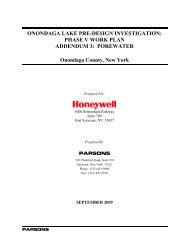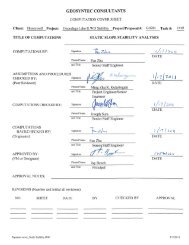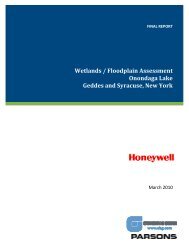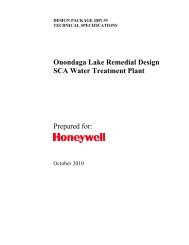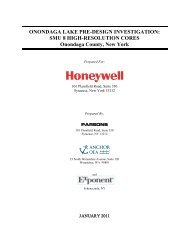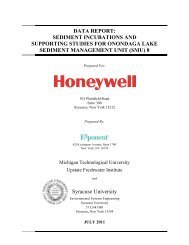Phase 1B Underwater Archaeological Report for the Onondaga ...
Phase 1B Underwater Archaeological Report for the Onondaga ...
Phase 1B Underwater Archaeological Report for the Onondaga ...
Create successful ePaper yourself
Turn your PDF publications into a flip-book with our unique Google optimized e-Paper software.
FINAL<br />
<strong>Phase</strong> IB <strong>Underwater</strong> <strong>Archaeological</strong> Resources <strong>Report</strong> <strong>for</strong> <strong>Onondaga</strong> Lake Superfund Site<br />
In 1884, <strong>the</strong> Solvay Process Company (SPC) came to <strong>Onondaga</strong> Lake to manufacture soda ash, a product<br />
with numerous applications including manufacturing glass and detergents (Figure 12). The area<br />
provided <strong>the</strong> ideal environment and resources needed <strong>for</strong> <strong>the</strong> Solvay process of creating soda ash: <strong>the</strong>re<br />
was salt water from <strong>the</strong> nearby springs; calcium carbonate from <strong>the</strong> surrounding limestone bedrock; and<br />
easy disposal of waste product into and around <strong>Onondaga</strong> Lake. Millions of pounds of chloride, sodium,<br />
and calcium, were discharged into <strong>Onondaga</strong> Lake. 80<br />
SPC added a new plant in 1918 to produce chlorine and a variety of organic chemicals resulting in<br />
hundreds of thousands of pounds of mercury, among o<strong>the</strong>r various chemicals, being released into <strong>the</strong><br />
lake. Between 1900 and 1940, a number of o<strong>the</strong>r industries were established in <strong>the</strong> region, including<br />
steel, pottery, pharmaceutical, air conditioning, appliance, and electrical manufacturing facilities, many<br />
of which contributed o<strong>the</strong>r solvents and organic chemicals such as benzene and polychlorinated<br />
biphenyls (PCBs). Allied-Signal (a successor to Solvay Process Company) closed <strong>the</strong> soda ash production<br />
facility in 1986, and <strong>the</strong> company now exists under Honeywell.<br />
Figure 12. Postcard of <strong>the</strong> Solvay Process Works (from www.vintageviews.org, n.d.).<br />
As <strong>the</strong> industrial revolution took hold and populations around <strong>the</strong> lake grew, <strong>the</strong> disposal of domestic<br />
and municipal waste became common. During <strong>the</strong> turn of <strong>the</strong> twentieth century sewage waste was<br />
being discharged directly into <strong>Onondaga</strong> Lake, as well as into <strong>Onondaga</strong> Creek and Harbor Brook. 81 This<br />
issue escalated in <strong>the</strong> 1920s when <strong>the</strong> city installed a 1700 foot (518m) outfall sewer in to <strong>the</strong> lake. The<br />
excessive raw sewage in <strong>the</strong> lake led to increased nitrate and phosphorous concentrations in <strong>the</strong> water,<br />
which in turn led to algae blooms and fish die-offs. 82<br />
The environmental impact of <strong>the</strong> pollution was detrimental to o<strong>the</strong>r smaller commercial enterprises. In<br />
<strong>the</strong> 1800s a viable commercial cold-water fishery was sustained by <strong>the</strong> various fish from <strong>the</strong> lake;<br />
whitefish, Atlantic salmon and sturgeon were particularly popular. However, by 1890 <strong>the</strong> fishery had<br />
closed and by 1898 <strong>the</strong> whitefish population in <strong>the</strong> lake had disappeared. Ice-harvesting, ano<strong>the</strong>r<br />
20



